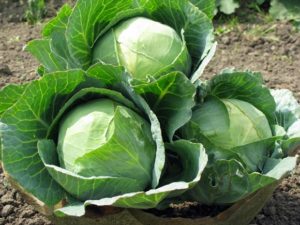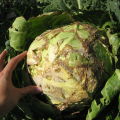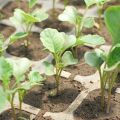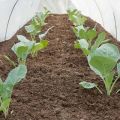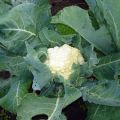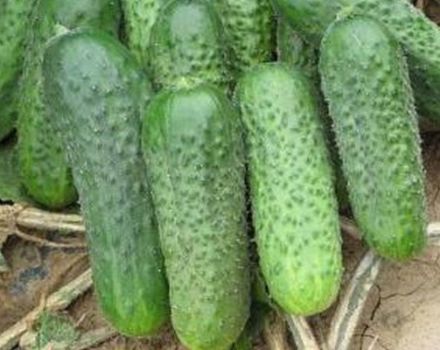Growing and caring for Kohlrabi cabbage in the open field
Kohlrabi cabbage began to gain popularity relatively recently. Most often, it is cultivated by experienced vegetable growers who like to grow vegetables in their garden. This variety is a dietary product that can be eaten boiled, stewed and raw. To get a good harvest of cabbage Kohlrabi, cultivation and care will have to be done correctly. Only by observing all the rules can you increase the yield.
Short description
Before growing Kohlrabi cabbage in the open field, you must familiarize yourself with the description of its main characteristics.
During growth, the stem of the plant begins to develop first. It appears much earlier than the heads of cabbage are tied. The bush is covered with large dark green leaves. The edible part of Kohlrabi is its stembread, which is very much like a turnip in shape. By their taste, Kohlrabi cabbage varieties are very reminiscent of cabbage stump. However, Kohlrabi's stem is sweeter and more juicy.
It contains a greater amount of active biological elements and vitamins that the human body needs. Vegetable sizes can be completely different - from 0.5 to 1 kg.
Growing seedlings
The cultivation of Kohlrabi cabbage begins with planting seeds for seedlings. Many gardeners who have not grown cabbage before do not know when to plant Kohlrabi for seedlings. It is recommended to sow it a month and a half before planting seedlings in the garden.
To obtain an early harvest, planting material is planted in greenhouses in the first half of March. In this case, the first fruits can be harvested after three months. To get a late harvest, Kohlrabi cultivation begins in early May. This will allow harvesting the first fruits in the second half of July. People living in the Moscow region and residents of the Moscow region can plant seeds a little earlier.

Seed preparation
To make the seeds of Kohlrabi cabbage germinate more intensively, it is recommended to soak them in a special solution made from aloe, boric acid and copper sulfate.
There is also another way to prepare seeds for planting. To do this, several layers of a thick towel are placed on a plate, on which the grains are placed. Then all this is filled with water and infused for 2-4 hours. The water is drained and the seeds are left in a room at room temperature overnight. In the morning, all the seeds are poured out of the plate into a plastic bag and kept in it for 12-20 hours.
Growing from seeds will take place without problems only if the seed is disinfected in advance.
Quite often, heat treatment of grains is used for this. However, it should be borne in mind that after carrying out this procedure, the number of seeds suitable for planting will significantly decrease. Cabbage seeds do not tolerate too high temperatures, so they need to be warmed up in water heated to 30-40 degrees.
Soil preparation
In order for the cabbage to quickly set into the head of cabbage, it is necessary to grow it in pre-prepared soil. It is created from a nutrient mixture on which the quality of seedlings largely depends. The owners of summer cottages will be able to easily create an excellent soil mixture to grow cabbage in it.
It is recommended to do this in the fall, so that by the spring the soil can freeze well and warm up. For growing young seedlings, it is recommended to use porous and loose soil, which has a low acidity level. This will facilitate the flow of moisture and its retention in the soil. It is advisable to use forest turf soil mixed with sand and humus. However, it is not always possible to go into the forest for soil and you have to use ordinary garden soil.
Landing
After the preparation of seeds and soil, Kohlrabi is planted. Seeds are planted in small pots filled with pre-prepared soil. It is not recommended to deeply deepen them into the ground. It will be enough to place the grains at a depth of about 2-3 cm. After planting the seeds, the soil must be moistened with water.
The planted cabbage should be kept under glass in a room with a temperature of at least 25 degrees. After the first shoots appear, the glass is removed and the seedlings are transferred to a cooler place.
Seedling care
When growing seedlings, it is recommended to water them regularly. Moisten the soil as needed. The main thing is that the ground is not too dry and the plant has enough moisture. You also need to protect the seedlings from dangerous diseases. To do this, it is sprayed several times with a weak manganese solution. After the appearance of the first two leaves, the first feeding of the seedlings is carried out, consisting of a liter of water and a teaspoon of mineral fertilizers.
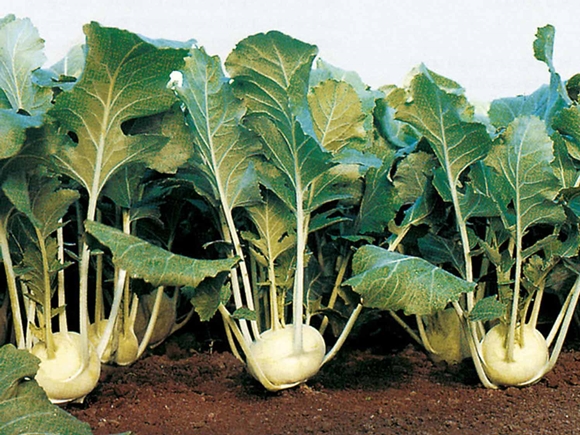
Caring for Kohlrabi cabbage also includes picking if the seeds were planted in one large container. The procedure is carried out after the first true leaf appears in the seedlings. It is recommended to transplant seedlings into separate peat pots.
Planting seedlings
Growing Kohlrabi cabbage in the open field begins with planting its seedlings in the soil. Before you grow Kohlrabi, you need to figure out when to plant it in the garden. To get a good harvest, it is recommended to plant it under films at the end of May. If there is no film, then sowing will have to be postponed to the first half of June.
Seedling preparation
Hardening of seedlings is carried out after the outside air temperature rises to 15 degrees. In order for the seedlings to get used to the outdoor temperature regime, they must be periodically taken out of the room. For this, places that are not illuminated by the sun are selected, which are well protected from the wind.
First, it is recommended to take out the pots of cabbage at noon so that the air outside is well warmed up. You need to bring the seedlings back after the sun begins to set. Gradually the time spent on the street increases. A few days before planting the seedlings in the soil, the pots will need to be taken outside overnight. In this case, it is recommended to monitor the night temperature. If it is too low, then you will have to cover the bushes with film or paper caps.
Site preparation
The main advantage of Kohlrabi cabbage is that it is not very demanding on the quality of the soil. It grows well in almost any type of soil.The main thing is that he is not too depleted or has high acidity. If grown in such soil, the ovary will grow more slowly. Therefore, it is recommended to check the pH value before planting seedlings. It should be in the range of 6-7 pH.
Site preparation should be done in early autumn. During this period, you should dig up the ground to the depth of one bayonet. Then several kilograms of organic fertilizers, a tablespoon of superphosphate, urea and wood ash are added to the soil.
Disembarkation
Many do not know why cabbage is not tied. This problem can occur if it was not properly planted. It is better to plant young seedlings in the evening or on a cloudy day, so that there is no sun. The beds are created according to one of two schemes: 70x30 or 60x40 cm. Before placing the seedlings in the hole, you must add several glasses of ash, a tablespoon of urea and superphosphate to them.
The seedlings are buried in the soil until the roots are completely underground. It is not recommended to plant it too deeply, as this may cause early flowering or disrupt the formation of the stem. Having planted all the seedlings in the soil, it is carefully watered and compacted so that the water does not evaporate too quickly.
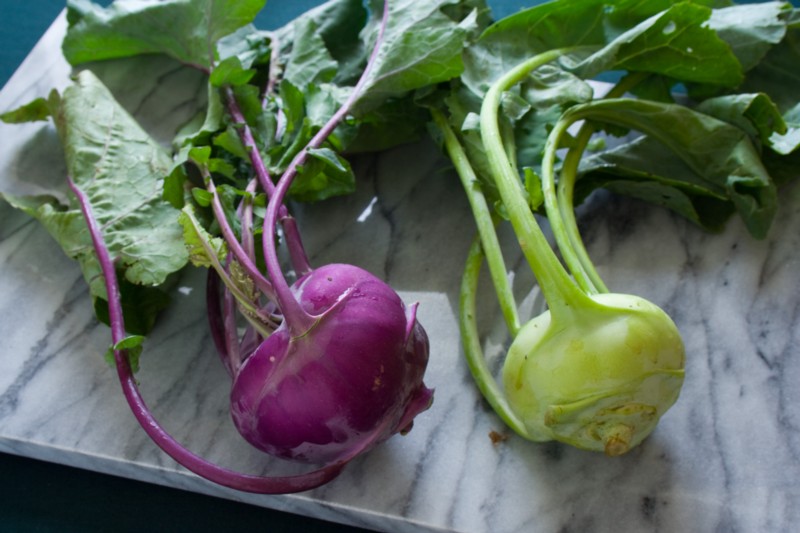
Care
Grown cabbage needs proper care. There are various reasons why you need to take care of your vegetables while growing. The main one is getting a good harvest.
Watering
Kohlrabi care should include periodic watering of the plants. When growing cabbage, you need to water it every three days. After it is completely absorbed, it will be enough to moisten the soil once a week.
June is the hottest days, and it is recommended to water the bushes daily so that the soil does not have time to dry out.
Top dressing
During cultivation, the cabbage is fertilized three times. The first time the procedure is carried out after the appearance of the first leaves. During this period, mineral trace elements and complex fertilizers are introduced into the soil. The next time the bushes are fed three weeks after planting the seedlings. The site is sprayed with a sulfate solution prepared from 10 liters of water and a tablespoon of potassium sulfate.

Cleaning
People who have not previously grown Kohlrabi do not know when to remove Kohlrabi cabbage from the garden. It ripens within 90 days after being planted in the garden. It is after such a period of time that you need to harvest. For this, a clear and sunny day is chosen. It is recommended to dig up stems with roots that will need to be cut and discarded in the future. However, some do not cut them and leave them on the stems of the harvested crop.
Conclusion
Even a novice gardener who has never done this before can grow such a cabbage. To do this, it is enough to familiarize yourself with the features of its cultivation and find out when to harvest Kohlrabi cabbage.

